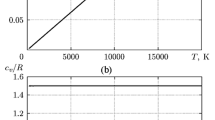Abstract
The effect of diluents of various chemical nature [halogenated hydrocarbons, inhibitors developed at the Institute of Structural Macrokinetics and Problems of Materials Science (ISMAN), superheated water aerosol] on the flammability limits of hydrogen-methane mixtures in air was investigated experimentally. It was found that ISMAN inhibitors, which are aliphatic hydrocarbons, reduce the upper flammability limit of hydrogen even more effectively than the well-known inhibitor 1,2-dibromotetrafluoroethane. Flammability curves for hydrogen and methane in mixtures with the above-mentioned diluents were obtained. The results are interpreted qualitatively by considering various kinetic regimes of nonisothermal chain branching reactions.
Similar content being viewed by others
References
A. S. Sokolik, Self-Ignition, Flame, and Detonation in Gases [in Russian], Izd. Akad. Nauk SSSR (1960).
H. F. Coward and G. W. Jones, “Limits of flammability of gases and vapors,” Bureau of Mines, Bull. No. 503, Washington (1952).
M. G. Zabetakis, “Flammability characteristics of combustible gases and vapors,” Bureau of Mines, Bull. No. 627, Washington (1965).
Yu. N. Shebeko, “Inertion and inhibition of combustion processes,” in: Anniversary Selected Papers of the Institute of Fire Protection, Moscow (1997), pp. 69–91.
E. W. Heinonen and S. R. Skaggs, “Fire suppression and inertion testing of halon 1301 replacement agents,” in: Proc. Halon Alternatives Technical Working Conference, Univ. of New Mexico, Albuquerque (1997), pp. 213–224.
R. G. Zalosh and R. J. Edwards, “Propane inerting concentrations of two halon replacement gases blended with nitrogen,” Proc. Halon Alternatives Technical Working Conference, Univ. of New Mexico, Albuquerque” (1994), pp. 241–250.
Y. Ogawa, N. Saito, and Y. Saito, “Effect of interaction between halogenated fire suppressants and inert gas on extinction limit of premixed flame,” ibid. (1997), pp. 106–119.
Yu. N. Shebeko, A. Ya. Korol’chenko, S. G. Tsraichenko, et al., “Effects of the initial pressure and temperature on the combustion characteristics of hydrogen-containing mixtures,” Combust., Expl., Shock Waves, 25, No. 3, 289–292 (1989).
Yu. N. Shebeko, A. Ya. Korolchenko, A. V. Trunev, and V. Yu. Navzenya, “The influence of a superheated water aerosol on flammability limits and laminar burning velocities of a premixed methane-air flame,” in: Proc. of the First Int. Seminar on Fire and Explosion Hazard of Substances and Venting of Deflagrations, Moscow (1995), pp. 362–365.
A. Ya. Korolchenko, Yu. N. Shebeko, A. V. Trunev, et al., “Influence of the aerosol formed in the rapid evaporation of superheated water on the combustion of methane-air mixture in a closed vessel,” Combust., Expl., Shock Waves, 31, No. 2, 148–152 (1995).
V. V. Azatyan, I. A. Bolod’yan, V. Yu. Navtsenya, and Yu. N. Shebeko, “Dominating role of the competition of chain branching and termination reactions in the formation of flammability limits,” Zh. Fiz. Khim., 76, No. 5, 775–784 (2002).
G. Dixon-Lewis, “Flammability and chemical inhibition,” in: Proc. of the First Int. Seminar on Fire and Explosion Hazard of Substances and Venting of Deflagrations, Moscow (1995), pp. 362–365.
Yu. N. Shebeko, W. Fan, I. A. Bolodian, and V. Yu. Navzenya, “An analytical evaluation of flammability limits of gaseous mixtures of combustible-oxidizer-diluent,” Fire Safety J., 37, No. 8, 549–568 (2002).
F. A. Williams, Combustion Theory, Addison Wesley Publishing Company, London (1969).
Z. H. Chen and S. H. Sohrab, “Flammability limits and limit temperature of counterflow lean methane-air flames,” Combust. Flame, 102, Nos. 1/2, 193–199 (1995).
V. V. Azatyan, I. A. Bolod’yan, Yu. N. Shebeko, and S. N. Kopylov, “Critical conditions of chain thermal explosion,” Combust., Expl., Shock Waves, 37, No. 5, 501–511 (2001).
V. V. Azatyan, I. A. Bolod’yan, S. N. Kopylov, et al., “Kinetic regimes of developed chain combustion,” Combust., Expl., Shock Waves, 39, No. 3, 354–363 (2003).
V. V. Azatyan, I. M. Naboko, V. A. Petukhov, et al., “Chemical suppression of explosions of hydrogen-air mixtures under cumulation conditions during intense initiation of combustion,” Dokl. Akad. Nauk SSSR, 394, No. 1, 61–64 (2004).
V. V. Azatyan, G. G. Vagner, and G. K. Vedeshkin, “Effect of reactive additives on detonation in hydrogen-air mixtures,” Zh. Fiz. Khim., 78, No. 6, 1036–1044 (2004).
V. V. Azatyan, A. A. Borisov, A. G. Merzhanov, et al., “Inhibition of various hydrogen combustion regimes in air by propylene and isopropanol,” Combust., Expl., Shock Waves, 41, No. 1, 1–11 (2005).
N. N. Semenov, Some Problems of Kinetics and Reactivity [in Russian], Izd. Akad. Nauk SSSR (1958).
Ya. B. Zel’dovich, G. I. Barenblatt, V. B. Librovich, and G. M. Makhviladze, The Mathematical Theory of Combustion and Explosions, Plenum, New York (1985).
G. Dixon-Lewis, “Laminar premixed flame extinction limits. 1. Combined effects of stretch and upstream heat loss in the twin-flame unburnt-to-unburnt opposed flow configuration,” Proc. Roy. Soc. London, A452, No. 9, 1857–1884 (1996).
Author information
Authors and Affiliations
Additional information
__________
Translated from Fizika Goreniya i Vzryva, Vol. 42, No. 6, pp. 96–102, November–December, 2006.
Rights and permissions
About this article
Cite this article
Azatyan, V.V., Shebeko, Y.N., Bolod’yan, I.A. et al. Effect of diluents of various chemical nature on the flammability limits of gas mixtures. Combust Explos Shock Waves 42, 708–714 (2006). https://doi.org/10.1007/s10573-006-0105-8
Received:
Issue Date:
DOI: https://doi.org/10.1007/s10573-006-0105-8



